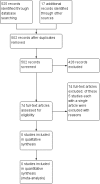Newborn screening for galactosaemia
- PMID: 29274129
- PMCID: PMC6485983
- DOI: 10.1002/14651858.CD012272.pub2
Newborn screening for galactosaemia
Update in
-
Newborn screening for galactosaemia.Cochrane Database Syst Rev. 2020 Jun 22;6(6):CD012272. doi: 10.1002/14651858.CD012272.pub3. Cochrane Database Syst Rev. 2020. PMID: 32567677 Free PMC article.
Abstract
Background: Classical galactosaemia is an autosomal recessive inborn error of metabolism caused by a deficiency of the enzyme galactose-1-phosphate uridyltransferase. This is a rare and potentially lethal condition that classically presents in the first week of life once milk feeds have commenced. Affected babies may present with any or all of the following: cataracts; fulminant liver failure; prolonged jaundice; or Escherichia coli sepsis. Once the diagnosis is suspected, feeds containing galactose must be stopped immediately and replaced with a soya-based formula. The majority of babies will recover, however a number will not survive. There are long-term complications of galactosaemia, despite treatment, including learning disabilities and female infertility. It has been postulated that galactosaemia could be detected on newborn screening and this would prevent the immediate severe liver dysfunction and sepsis.
Objectives: To assess whether there is evidence that newborn screening for galactosaemia prevents or reduces mortality and morbidity and improves clinical outcomes in affected neonates and the quality of life in older children.
Search methods: We searched the Cochrane Cystic Fibrosis and Genetic Disorders Group Trials Register comprising references identified from electronic database searches, handsearches of relevant journals and conference abstract books. We also searched online trials registries and the reference lists of relevant articles and reviews.Date of the most recent search of Cochrane Cystic Fibrosis Group's Trials Register: 18 December 2017.Date of the most recent search of additional resources: 11 October 2017.
Selection criteria: Randomised controlled studies and controlled clinical studies, published or unpublished comparing the use of any newborn screening test to diagnose infants with galactosaemia and presenting a comparison between a screened population versus a non-screened population.
Data collection and analysis: No studies of newborn screening for galactosaemia were found.
Main results: No studies were identified for inclusion in the review.
Authors' conclusions: We were unable to identify any eligible studies for inclusion in this review and hence it is not possible to draw any conclusions based on randomised controlled studies. However, we are aware of uncontrolled studies which support the efficacy of newborn screening for galactosaemia. There are a number of reviews and economic analyses of non-trial literature suggesting that screening is appropriate.
Conflict of interest statement
All the authors of this Cochrane Review declare that there are no conflicts of interest.
References
References to studies excluded from this review
-
- Crabbe MJ, Freeman G, Halder AB, Bron AJ. The inhibition of bovine lens aldose reductase by Clinoril, its absorption into the human red cell and its effect on human red cell aldose reductase activity. Ophthalmic Research 1985;17(2):85‐9. - PubMed
-
- Knerr I, Coss KP, Kratzsch J, Crushell E, Clark A, Doran PP, et al. Effects of temporary low‐dose galactose supplements in children of over 5 years with Classical Galactosaemia. Journal of Inherited Metabolic Disease 2014;37 Suppl 1:S101.
-
- Manis FR, Cohn LB, McBride‐Chang C, Wolff JA, Kaufman FR. A longitudinal study of cognitive functioning in patients with classical galactosaemia, including a cohort treated with oral uridine. Journal of Inherited Metabolic Disease 1979;20(4):549‐55. - PubMed
-
- Panis B, Vermeer C, Kroonenburgh MJ, Nieman FH, Menheere PP, Spaapen LJ, et al. Effect of calcium, vitamins K1 and D3 on bone in galactosemia. Bone 2006;39(5):1123‐9. - PubMed
-
- Schon R. Preliminary results with the rapid fluorescence test (Weidemann) as mass screening procedure for galactosaemia in newborn infants (author transl). Wiener Klinische Wochenschrift 1976;88(8):274‐7. - PubMed
Additional references
-
- Botkin JR. Research for newborn screening: developing a national framework. Pediatrics 2005;116(4):862‐71. - PubMed
-
- Fridovich‐Keil JL, Walter JH. Chapter 72: Galactosemia. The Online Metabolic & Molecular Bases of Inherited Disease. ommbid.mhme... (accessed prior to 06 March 2017):1‐20.
Publication types
MeSH terms
LinkOut - more resources
Full Text Sources
Other Literature Sources
Medical


